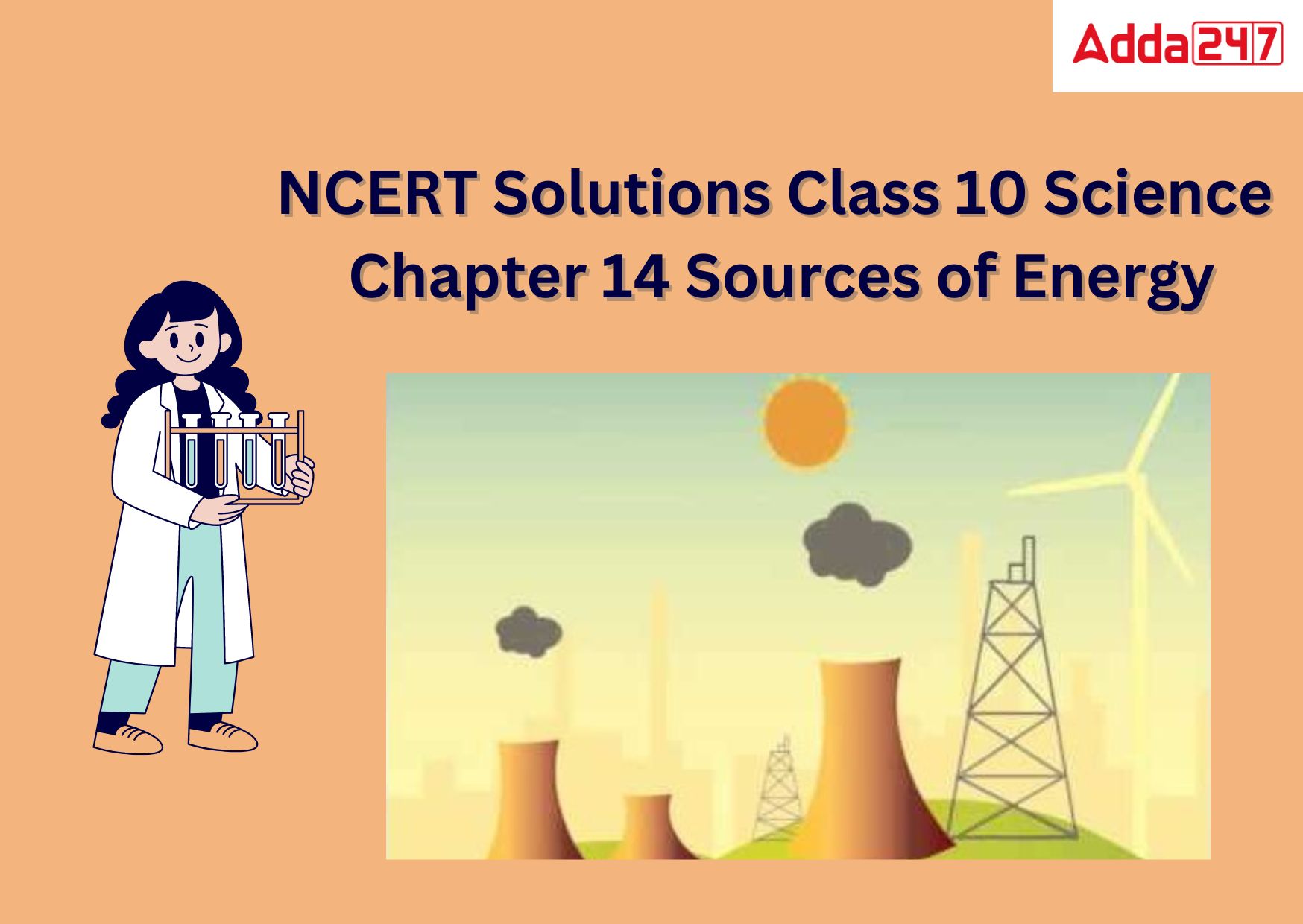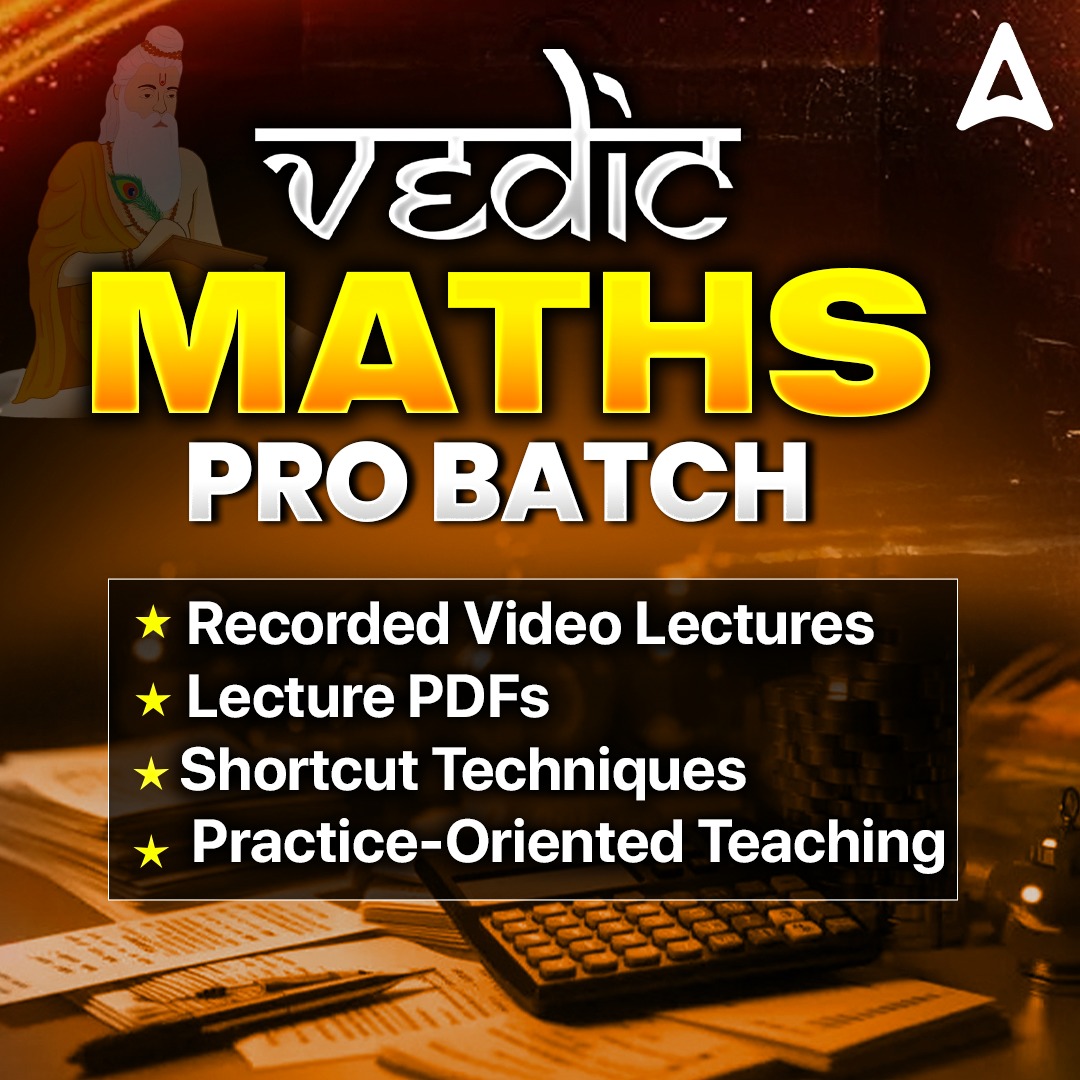NCERT Solutions Class 10 Science Chapter 14- Sources of Energy
NCERT Solutions Class 10 Science Chapter 14 Sources of Energy are given in the article.NCERT books are the best resource for obtaining a good score in the class 10 board Examination. Here are Adda247 Expert faculty team prepared NCERT Solutions Class 10 Science Chapter 14 Sources of Energy along with in-text questions and exercises of that chapter for a better grasp of the topics. So that students can pass their board exam with flying colours.Keep learning with Adda247.
NCERT Solutions for Class 10 Science Chapter 14- Sources of Energy PDF
Click here to download NCERT Solutions Class 10 Science Chapter 14 Sources of Energy
Sources of Energy- An Overview
Good Sources of Energy – Definition
A good source of energy would consequently be one that does a lot of work per unit volume or mass, it is simple to get and simple to store and carry. Good source of energy probably most significantly, simple to use and cost-efficient.
Sources of Energy- Types
There are various sources of energy. These sources are categorized as follows:
- Renewable Energy-The “renewable energy” refers to the energy that comes from renewable natural resources such as the sun, wind, water, etc. These renewable energy sources can produce solar energy, wind energy, water energy, coal energy, and other types of energy.
- Non-Renewable Energy- Non-renewable energy comes from sources such as coal, oil, and natural gas that are consumed, but cannot be restored again. In the current situation, This type of energies most widely used as a Source of energy. They produced a lot of pollutants when burned, they are less environmentally beneficial than renewable resources.
Conventional Sources of Energy – Types
- Fossil Fuels
- Thermal Power Plant
- Hydro Power Plants
Improvements in the Technology for using Conventional Sources of Energy
- Biomass
- Wind Energy
Non- Conventional Sources of Energy
- Solar energy
- Tidal energy
- Wave energy
- Ocean thermal energy
- Geothermal energy
- Nuclear energy
Sources of Energy: Video Explanation Part 1
Sources of Energy: Video Explanation Part 2
Sources of Energy: Video Explanation Part 3
NCERT Solutions Class 10 Science Chapter 14: Sources of Energy- Questions and Answers
In-text Questions Page:243
Question 1: What is a good source of energy?
Answer: A good energy source is an energy source capable of supplying adequate, secure energy at a constant rate for a considerable amount of time which is easily available, economical, and has less environmental pollution.
So, Some characteristics of a good source of energy are
1. An excellent source of energy would be one that performed a lot of work per unit of mass or volume.
2. It should be easily available
3. It is simple to transport and store
4. It should be cost-effective.
Question 2: What is a good fuel?
Answer a good Fuel is considered a Source of energy that is capable of producing a good amount of heat or energy. A good fuel must be easily accessible, economical, and produce less amount of carbon footprint.
Question 3: If you could use any source of energy for heating your food, which one would you use it and why?
For heating or cooking my food, I would like to use Natural gas as a source of energy because’
- It is simple to use
- It is readily accessible.
- Easily portable
- Simple to store
- Less smoke is generated.
In-text Questions Page:248
Question 1. What are the disadvantages of fossil fuels?
There are several disadvantages to using fossil fuels. Burning fossil fuels have a very bad effect environment as well as the whole living being. Some disadvantages of fossil fuels are-
- By using fossil fuels, It produces various greenhouse gases like Carbon mono oxide, Methene, Carbon dioxide, and many more. These greenhouse gases result in global warming.
- Coal and petroleum products a huge amount of smoke, which results in air pollution, Air population causes various Lung diseases and cancer in humans.
- The carbon, nitrogen, sulfur, and other oxides emitted by fossil fuels have an impact on the fertility of the soil and the quality of potable water.
Question 2. Why are we looking at alternate sources of energy?
Since fossil fuels are not renewable sources of energy and are being used widely, they will eventually run out of use. We will be left with nothing when fossil fuel energy sources are completely run out, so we are looking at alternate sources of energy.
Question 3. How has the traditional use of wind and water energy been modified for our convenience?
In earlier days, The uses of wind energy are very limited. wind energy was harnessed by using windmills to carry out mechanical tasks like lifting or collecting water from a well. But with time, a shortage of fossil fuel, and wind energy in windmills is used to generate electricity. The rotatory action of the wind mils blades turns the turbine of the electric generator to generate power. As a result, converts the kinetic energy of the wind into electricity,
As waterfalls were a source of potential energy, too However, waterfalls have become fewer in recent years. Water dams are being built artificially to produce energy s an alternative energy Water is directed onto the turbine at a specific height and the electric generator generates power.
In-text Questions Page: 253
Question 1. What kind of mirror – concave, convex, or plain – would be best suited for use in a solar cooker? Why?
Answer: We can use a concave mirror in a solar cooker.
Sunlight serves as both the heating and cooking source for solar cookers. To reflect and concentrate the sunlight in one spot, a concave mirror can be utilized in a solar cooker, As it concentrates all the sunshine at one point, raising the temperature. So that we can be easily heated and cooked our meals.
Question 2. What are the limitations of the energy that can be obtained from the oceans?
Tidal energy, wave energy, and ocean thermal energy are the various types of energy that can be derived from the ocean. The following are some limitations on the energy produced by the ocean:
- Tidal energy production requires very large, powerful waves.
- Changes the intensity of sea waves because it depends on the rotation of the earth and the relative positions of the moon, earth, and sun.
- Tidal power plant construction costs are expensive.
- There may be a high expense associated with building very large dams to create ocean energy.
- Building such massive dams, which have a negative effect on marine life,
Question 3. What is geothermal energy?
As a result of geological changes, molten rocks from the earth’s crust’s deeper heated regions are forced upward and locked in specific areas known as “hot spots.” There are occasionally outlets for the hot water there. Hot springs are this kind of outlet. To create electricity, a turbine is connected via a pipe to the trapped steam in the rocks. When energy can be obtained from these hot spots is known as Geothermal energy. Geothermal energy is essentially energy that is derived from the earth.
Question 4. What are the advantages of nuclear energy?
Answer: The advantages of nuclear energy are as follows:
- A large amount of energy is produced per unit of mass.
- It also has one of the smallest carbon footprints due to the fact that it does not emit any pollutants.
- The energy generated by burning 1 atom of carbon is 10 million times greater when 1 atom of uranium is fissioned.
14.4 ENVIRONMENTAL CONSEQUENCES
Question 1:Can any source of energy be pollution-free? Why or why not?
Answer: No. We can’t say that there is no source of energy that is 100% pulsation-free. Primarily, it is thought that producing solar energy is pollution-free. But the production of solar plates could harm the ecosystem. In the case of water energy, Building high dams directly affect marine life and result in floods. As a result, no energy source is pollution-free.
Question 2: Hydrogen has been used as rocket fuel. Would you consider it a cleaner fuel than CNG? Why or why not?
Answer: Yes. Hydrogen is clear fuel is CNG. Hydrocarbons are present in CNG. As result, while burning CNG, carbon is produced as waste. on the other hand, hydrogen is waste-free,as there are no byproducts of hydrogen fusion. Consequently, hydrogen is a cleaner rocket fuel than CNG.
In-text Questions Page: 254
Question 1. Name two energy sources that you would consider to be renewable. Give reasons for your choices.
Answer: Two renewable energy sources are Solar energy and Wind energy
Solar energy: The sun is the source of energy used to create solar energy. It is created through the continued fusion of hydrogen with helium w. The sun has an enormous supply of hydrogen and helium that will never run out. So, Solar energy is a source of energy that is renewable.
Wind energy: Wind energy is produced in windmills by the rotatory action of the wind mils blades and turns the turbine of the electric generator to generate power. As a result, converts the kinetic energy of the wind into electricity. Since wind energy is produced by air blowing at a high speed, the earth’s temperature influences the wind’s velocity. Since the earth will always be heated, the wind will always be available.
Question 2. Give the names of two energy sources that you would consider to be exhaustible. Give reasons for your choices.
Answer: The two types of energy that cannot be exhaustible are as follows:
Coal: The dead plant and animal remnants that were buried for a long time are the source of coal. The demand for coal has risen as a result of industrialization and cannot be met. Consequently, coal is a finite source of energy.
Petroleum: Like coal, petroleum is a fossil fuel produced by dead plants and animal remnants that were buried for a long time. In recent times due to industrialization, and the wide use of fossil-fuel cars, the storage of Petroleum is about to finish in near future. So It is not possible to exhaustible.
Ncert Solutions for Class 10 Science Chapter 14- Sources of Energy Exercises
Question 1. A solar water heater cannot be used to get hot water on
(a) a sunny day. (b) a cloudy day.
(c) a hot day. (d) a windy day.
Answer:(b) a cloudy day.
A solar water heater heats water using solar energy or sunlight. Because the sunshine won’t be strong and sufficient on a cloudy day. We cannot use a solar water heater to get hot water on(b) a cloudy day
Question 2. Which of the following is not an example of a bio-mass energy source?
(a) wood (b) gobar-gas
(c) nuclear energy (d) coal
Answer: Nuclear Energy.
The dead plants and animal faeces are converted into biomass. Wood is a component of plants, gobar gas is made from animal waste, and coal is made from the decomposing bodies of plants and animals. Wood, gobar gas, and coal are the direct or indirect products of plants. On the other hand and However, nuclear energy is created when atoms fuse and split, releasing enormous amounts of energy in the process.
Question 3. Most of the sources of energy we use represent stored solar energy. Which of the following is not ultimately derived from the Sun’s energy?
(a) geothermal energy (b) wind energy
(c) nuclear energy (d) biomass.
Answer:c) Nuclear energy
The rest of the listed energy sources are directly or indirectly influenced by the sun. But Nuclear fusion and nuclear fission are both sources of nuclear energy. Nuclear reactions can occur without sunshine and yield enormous amounts of energy.
Question 4. Compare and contrast fossil fuels and the Sun as direct sources of energy.
Answer:
| Point of Comparison | Sun | Fossil fuel |
| Nature | Renewable | Non-Renewable |
| Pollution | Sunlight does not cause any pollution. | Fossil fuels produce various pollutants and harmful gases |
| Accessibility | Solar light is only used morning . To use at the night we have to store it. | The usage of fossil fuels is always possible. |
| Products | Sunlight is used by equipment like solar cells, solar heaters, solar cookers, etc. to produce energy. | Fossil fuels include coal, crude oil, Natural gases, etc. |
5. Compare and contrast bio-mass and hydro electricity as sources of energy.
Answer:
| Point of Comparison | Bio-mass | Hydroelectricity |
| Production | Biomass is produced from organic materials like wood, agricultural waste, and cow dung. | Hydroelectricity is produced by using the potential energy of stored water. and convert it into the electricity |
| Cost | Relatively low cost. | High Cost.It can only be created by building a hydroelectric plant. |
| Utilization | It can only be used for cooking and heating. | It can be used to power all kinds of electrical devices. |
| Pollution | Air pollution results from burning Biomass | It doesn’t pollute the environment. |
6. What are the limitations of extracting energy from—
(a) the wind? (b) waves? (c) tides?
Answer: (a) the wind: Windmills use the wind to capture energy. The major limitation of wind energy is that it can only produce electricity at speeds greater than 15 km/h and the wind speed is not the same always.
b) Waves: To produce energy from Waves, extremely powerful ocean waves are required which is very uncertain.
c) Tide Energy limitation:
- Tidal energy production requires very large, powerful waves.
- Changes the intensity of sea waves because it depends on the rotation of the earth and the relative positions of the moon, earth, and sun.
- Tidal power plant construction costs are expensive.
Question 7. On what basis would you classify energy sources as
(a) renewable and non-renewable?
(b) exhaustible and inexhaustible?
Are the options given in (a) and (b) the same?
Answer: Yes. Both are options are the same.
(a) Renewable and Non-renewable
A form of energy that replenishes itself in nature is referred to as renewable energy. Examples of renewable energy sources are the sun, wind, flowing water, biomass, and others.
A source of energy that does not naturally replenish is considered non-renewable. Coal, oil, natural gas, and other fossil fuels are examples of non-renewable energy sources.
(b) Exhaustible and Inexhaustible
The exhaustible energy source is one that will run out after a limited time period. The supply of coal, oil, and other nonrenewable energy sources is limited.
Inexhaustible energy sources are ones that won’t run out in the future and naturally replenish. Biomass, wind, and water are examples of Inexhaustible energy sources.
Question 8. What are the qualities of an ideal source of energy?
Answer: Some qualities of an ideal source of energy are
1. An excellent source of energy would be one that performed a lot of work per unit of mass or volume.
2. It should be easily available
3. It is simple to transport and store
4. It should be cost-effective.
Question 9. What are the advantages and disadvantages of using a solar cooker? Are there
places where solar cookers would have limited utility?
Answer:
Advantages of using solar cooker: A solar cooker uses the energy of the Sun to heat and prepare food. It is a renewable energy source that is both limitless and harmless to the environment.
Disadvantages of using solar cooker:
A major drawback of a solar cooker is its price. Without sunshine, it is impossible to function. As a result, it is ineffective on a cloudy day.
• In areas with very short days or year-round cloud cover, the use of solar cookers is limited.
Question 10. What are the environmental consequences of the increasing demand for energy?
What steps would you suggest to reduce energy consumption?
Answer: Industrialization causes a surge in energy demand. Fossil fuels, which are easily accessible energy sources, can meet this need. The environment is significantly harmed by the rising use of fossil fuels. By increasing the number of greenhouse gases in the atmosphere, the overuse of fossil fuels causes global warming and a rise in sea level.
It is not possible to entirely stop using fossil fuels. However, there are some steps that can be done to reduce energy consumption,
- Using electrical appliances and avoiding wasting electricity.
- The use of water shouldn’t be made unnecessary.
- It is necessary to establish a public transportation system, including mass transit, on a vast scale. These simple actions can assist you in reducing energy consumption.
Sources of Energy, NCERT Solutions for Class 10 Science Chapter 14-FAQs
Q. What is the meaning of an ideal source of energy?
A good energy source is an energy source capable of supplying adequate, secure energy at a constant rate for a considerable amount of time which is easily available, economical, and has less environmental pollution.
Q, What do you mean by non-renewable energy?
A source of energy that does not naturally replenish is considered non-renewable. Coal, oil, natural gas, and other fossil fuels are examples of non-renewable energy sources.
Q. What is renewable energy?
A form of energy that replenishes itself in nature is referred to as renewable energy. Examples of renewable energy sources are the sun, wind, flowing water, biomass, and others.












 CUET History Syllabus 2026 (Updated), Do...
CUET History Syllabus 2026 (Updated), Do...
 CUET General Test Syllabus 2026 (Latest)...
CUET General Test Syllabus 2026 (Latest)...
 CUET Economics Syllabus 2026, Exam Patte...
CUET Economics Syllabus 2026, Exam Patte...






